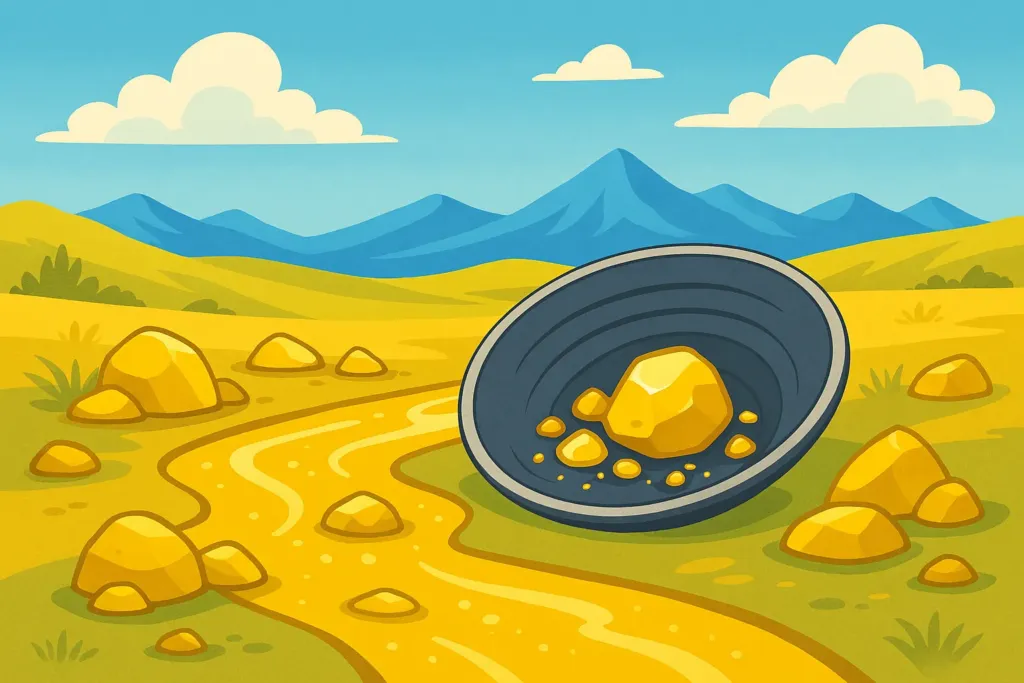Золото встречается в природе в виде самородков, золотой пыли и руд. Оно образуется в результате сложных геологических процессов, когда магматические или гидротермальные флюиды откладывают частицы металла в трещины и пустоты горных пород. Со временем вода и эрозия вымывают золото, и оно оседает в руслах рек, галечных отмелях и аллювиальных отложениях.
Туристам, интересующимся золотом, важно знать, что металл встречается в двух основных формах: россыпных месторождениях (речных песках и гравии) и жильных месторождениях (в горных породах). Россыпное золото легче добывать вручную, в то время как для добычи жильного золота требуется сложное оборудование.
Подробности и факты
— За всю историю человечества было добыто около 170 000 тонн золота, и большая его часть до сих пор находится в обращении.
— Среднее содержание золота в земной коре составляет около 0,005 грамма на тонну горной породы. — В некоторых реках содержание золота в песке может достигать 1 грамма на тонну, что делает промывку рентабельной даже для любителей.
— Самый большой самородок, когда-либо найденный, «Желанный незнакомец» в Австралии, весил 72 килограмма.
— Австралия, Китай, Россия и США являются лидерами по добыче золота.
Истории
В XIX веке золотые лихорадки в Калифорнии, Австралии и на Аляске изменили судьбу целых регионов. На Клондайке население выросло в десятки раз всего за несколько лет, а города возникали за считанные месяцы. В России Ленские прииски и Колымская зона славятся своей суровой историей горного дела. Сегодня эти места входят в туристические маршруты, сохраняя атмосферу тех времен.
Законность золотодобычи
— В разных странах действуют разные правила, и туристу важно заранее уточнить, разрешена ли золотодобыча и в каком виде.
– В Австралии, Новой Зеландии, некоторых штатах США и провинциях Канады существуют специальные лицензии или разрешения на любительскую промывку золота. Их можно получить онлайн или на месте, а стоимость обычно символическая.
– В некоторых странах, например, в России, самостоятельная добыча золота без лицензии запрещена. Туристы могут искать золото только в составе организованных туров или в специально отведенных местах.
– В национальных парках и на охраняемых природных территориях добыча золота практически всегда запрещена, даже в странах, где она, как правило, разрешена.
– Нарушение правил может повлечь за собой штрафы, конфискацию оборудования и даже уголовную ответственность, поэтому перед поездкой стоит изучить местные законы и условия туров.
– Легальные туристические программы по поиску золота обычно включают инструктаж, аренду оборудования и сопровождение гида, что делает процесс безопасным и законным.
Туристические места
– Клондайк, Канада — исторический регион золотой лихорадки. Посетители могут посетить музеи, старые шахты и попробовать себя в промывке золота в реке Юкон. – Виктория, Австралия — штат, где до сих пор работают золотые прииски. В городе Балларат музей под открытым небом «Соверен-Хилл» позволяет туристам окунуться в жизнь старателя.
– Колорадо, США — экскурсии по старым шахтам и золотопромывочным мастерским.
– Магаданская область, Россия — экскурсии по районам золотодобычи, включая заброшенные поселения и действующие прииски.
– Новая Зеландия — реки Отаго и Шотовер, где туристам разрешено искать золото с помощью простого оборудования.
Эти направления позволяют путешественникам не только увидеть процесс добычи, но и прикоснуться к истории, ощутить дух приключений и попытать счастья.
- Moab
- Great Plains (USA)
- Africa
- Irkutsk
- How to Get Around Australia
- Nicaragua
- Arabat Spit
- Monaco
- Morocco
- Glorious sea — sacred Baikal
- Honduras
- Minsk (Belarus)
- Saami
- Germany
- Alaska
- Finland
- Chukchi
- Win a four-night Greek getaway for two in one of the most stylish resorts in the Aegean courtesy of Sani Resort
- Shakira — Waka Waka (This Time for Africa)
- Daring to Explore Again

 France
France